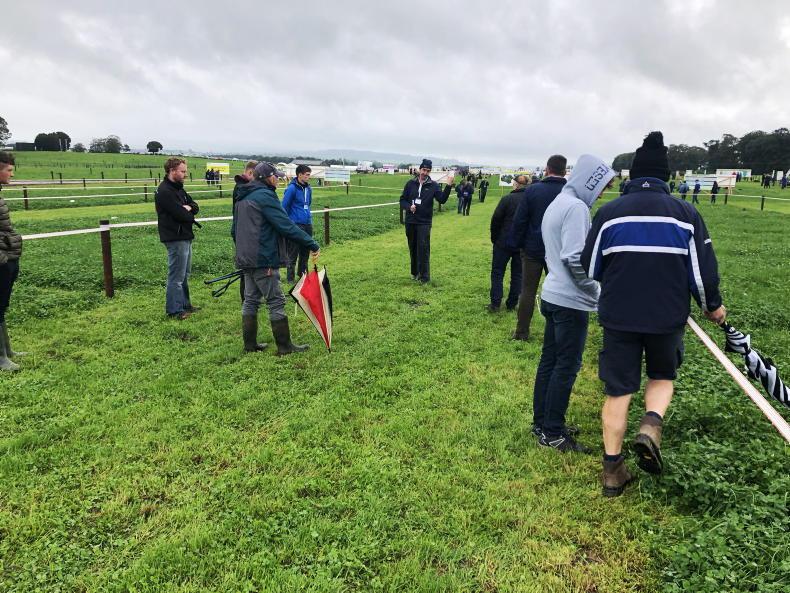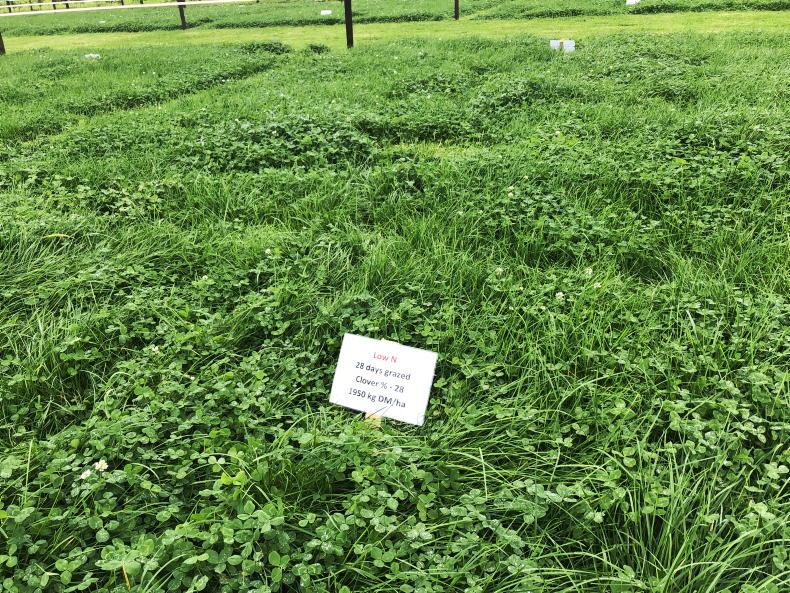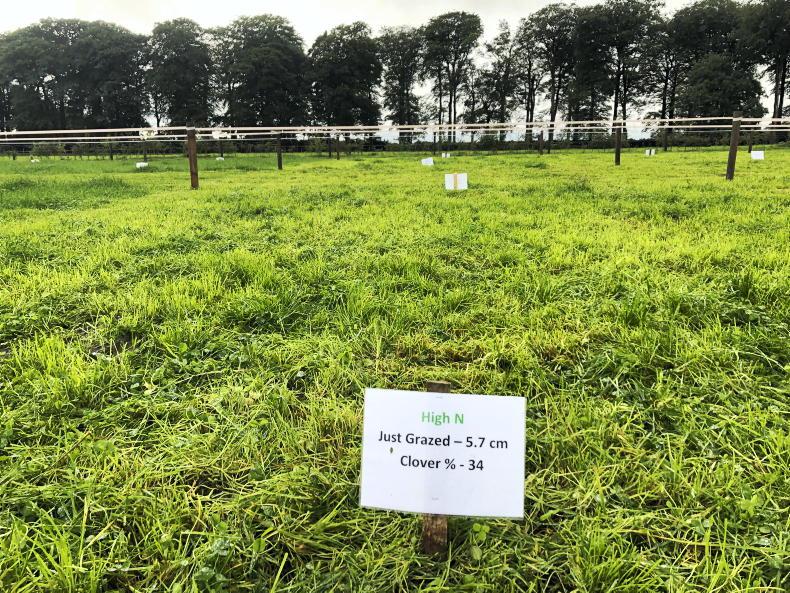Following on from the main boards at this year’s Moorepark Open Day, the grass village offers visitors an update on all things grass.
A range of topics were covered from clover and multi species sward trial work to Teagasc research farm updates, the pasture profit index (PPI) and Pasturebase Ireland.

Grazing demo at Moorepark 2021
The grazing demo also offers a visual demonstration of the different grass covers that should be on farm as peak average farm cover is targeted this week.

Groups are taken through the grazing demo by a Teagasc adviser..
Visitors are taken through the different plots where a Teagasc adviser will discuss pre-grazing covers, graze outs, nitrogen (N) application and clover content.
Keeping in tune with the theme of the day ‘Delivering on sustainability’, clover is top of the list when walking through the demo. The plots ranged from 25-32% clover content.
Nitrogen experiment
From the start of the grazing season to June all plots got the same treatment regarding N applications.
Each plot is then divided into high-N and low-N areas. The high-N areas got 20 units of N/ac and the low-N areas got 10 units of N/ac per round.
This equates to a difference of around 50 units of N/ac since the middle of June this year.

Grazing Demo Moorepark 2021 plot just grazed pregrazing cover was 1,800kg DM/ha.
The performance of the low-N areas with clover was one part of the demo that generated a lot of discussion with many groups on day one and two in Moorepark.
Even though the low-N areas have received 50 units less N, the difference in performance is minimal.

Low N sward at 28 days, 28% clover at 1,950kg DM/ha.
In the plots grazed 14 days ago, the cover was 800kg DM/ha on the low N with 28% clover and 830kg DM/ha on the high N with 26% clover. That is just a difference of just 30kg DM/ha.
This continued through the plots with a difference of only 50kg DM/ha between high- and low-N areas after 21 days.

Grazing demo Moorepark 2021 high-nitrogen sward poor graze out.
The final plot showed no difference between both the high-N area with 26% clover and the low-N area with 29% after 42 days.
Fencing
Advice on the day was that temporary fences should be used to achieve good graze outs from autumn covers over 2,000kg DM/ha while also trying to graze heavy covers during dry periods if possible.
The potential saving of reduced chemical nitrogen by incorporating the correct level of clover in to the sward (over 20%) left farmers with food for thought as they moved onto the next board.
Following on from the main boards at this year’s Moorepark Open Day, the grass village offers visitors an update on all things grass.
A range of topics were covered from clover and multi species sward trial work to Teagasc research farm updates, the pasture profit index (PPI) and Pasturebase Ireland.

Grazing demo at Moorepark 2021
The grazing demo also offers a visual demonstration of the different grass covers that should be on farm as peak average farm cover is targeted this week.

Groups are taken through the grazing demo by a Teagasc adviser..
Visitors are taken through the different plots where a Teagasc adviser will discuss pre-grazing covers, graze outs, nitrogen (N) application and clover content.
Keeping in tune with the theme of the day ‘Delivering on sustainability’, clover is top of the list when walking through the demo. The plots ranged from 25-32% clover content.
Nitrogen experiment
From the start of the grazing season to June all plots got the same treatment regarding N applications.
Each plot is then divided into high-N and low-N areas. The high-N areas got 20 units of N/ac and the low-N areas got 10 units of N/ac per round.
This equates to a difference of around 50 units of N/ac since the middle of June this year.

Grazing Demo Moorepark 2021 plot just grazed pregrazing cover was 1,800kg DM/ha.
The performance of the low-N areas with clover was one part of the demo that generated a lot of discussion with many groups on day one and two in Moorepark.
Even though the low-N areas have received 50 units less N, the difference in performance is minimal.

Low N sward at 28 days, 28% clover at 1,950kg DM/ha.
In the plots grazed 14 days ago, the cover was 800kg DM/ha on the low N with 28% clover and 830kg DM/ha on the high N with 26% clover. That is just a difference of just 30kg DM/ha.
This continued through the plots with a difference of only 50kg DM/ha between high- and low-N areas after 21 days.

Grazing demo Moorepark 2021 high-nitrogen sward poor graze out.
The final plot showed no difference between both the high-N area with 26% clover and the low-N area with 29% after 42 days.
Fencing
Advice on the day was that temporary fences should be used to achieve good graze outs from autumn covers over 2,000kg DM/ha while also trying to graze heavy covers during dry periods if possible.
The potential saving of reduced chemical nitrogen by incorporating the correct level of clover in to the sward (over 20%) left farmers with food for thought as they moved onto the next board.











 This is a subscriber-only article
This is a subscriber-only article











SHARING OPTIONS: